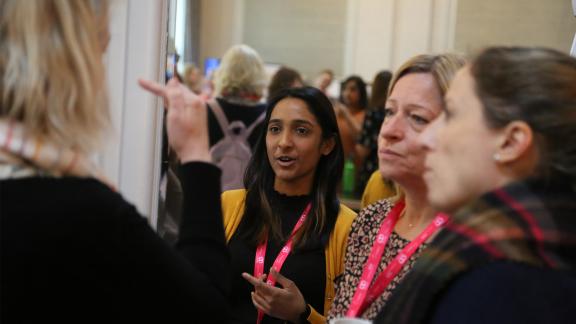
Foreword
Culture, the patterns of beliefs and behaviours in our organisations and systems, when aligned to strategy, is a powerful force. Organisation development (OD) professionals and academics have explored the concept of culture for decades, suggesting many ways of influencing and improving it. Culture change has a core theme in OD practice in the NHS, particularly in the years since the Francis Report recommended fundamental change in culture is needed across the NHS.
Culture is subjective. Organisations and systems are made up of many interconnected cultures. Teams have their own cultures. Regions have theirs. When we talk about culture in this resource it is shorthand for the multiple, sometimes complimentary, and at other times opposing, cultures that exist at all levels of the NHS.
We challenge the myths that culture is a single thing that can be changed by policy; that culture change takes a long time; and that culture cannot be changed. We believe culture change is possible, it can be immediate, and it happens through the conversations between people. While it can be helpful, and often necessary, to undertake a formal and structured approach to culture change, we offer a complimentary approach that says we can all change culture, all the time. This process begins by asking good questions.
This resource is built around ten culture provocations and ‘what if?’ statements that invite you to examine and challenge your views and practices. They have been developed by Stefan Cantore from foundations of research, through the lens of the challenge of changing culture in the NHS in 2021. Stefan is a senior university teacher in organisation development and management learning at the University of Sheffield Management School.
At the end of the provocations is a set of ten questions we encourage you to answer as a way of planning your next steps.
Good conversations that start with great questions lead to powerful action.
How to use this resource
Each of the ten provocations begins with a ‘what if?’ statement, followed by an idea challenge intended to help us look at culture through fresh eyes.
Provocations stimulate a reaction, sparking new questions and inquiries about our assumptions and practices. They disturb our thinking and unsettle us so that we become open to considering alternative perspectives.
We invite you to stay with the feelings and thoughts that come with these provocations. For some OD practitioners the ideas themselves might be familiar and prompt a milder response than for others. However, we can all do with re-examining our beliefs and practices so hopefully there is some challenge for everyone.
Stick with the ‘what if?’ questions. If they irritate you, then they are doing their job. Use them as an opener for your own analysis about the idea of organisational culture and how your OD practice might develop in response. Give yourself the time to chew them over. Perhaps use them as a starting point for a conversation with colleagues. We would also encourage you to create your own ‘what if?’ questions.
If you feel some energy around a particular provocation, you can explore deeper and dive into the topic in more detail. Each provocation also features practice challenges and ‘why not?’ suggestions. These are initial ideas about practical actions you might take.
Provocation 1: What if we don’t have an agreed definition of organisational culture?
Idea challenge
A Google search into the term organisational culture and a dip into academic literature will show that there is no one definition of the concept. Therefore, we need to do our own individual and collaborative thinking to come up with an understanding of the concept that fits well with us. Ed Schein (2004) identifies more than 11 categories used to describe culture, let alone the number of definitions. These range from observed repeated behaviour patterns, shared language, articulated values, rules of interaction, embedded skills, habits of thinking, metaphors, and symbols.
Schein goes on to suggest that while all of these might be relevant, the concept of culture brings with it the implication of what he calls ‘structural stability’ (Schein 2004, p. 15). This apparent stability offers a group a sense of meaning and predictability, both of which contribute to a sense of psychological safety. Furthermore, culture, as Schein sees it, is often something of which groups are largely unaware and shapes all their activities. When taken together, culture can be seen as a continuous patterning of behaviours and deep-seated beliefs that integrate our experiences and help us make sense of the environment in which we live and work.
Provocation 2: What if our OD approach to organisational culture is itself a reflection of the organisational culture we work in?
Idea challenge
We inhabit work environments that shape, albeit subconsciously, our behaviours and thinking as OD practitioners. The consequence is that when talking about organisational culture and working out how to change it, we are drawn to using the same language and behaviour patterns adopted by the organisation we work for. So, we find ourselves, almost inevitably, drawn into the patterns of culture transformation programmes, key performance indicators (KPIs), culture change tools, staff engagement strategies etc. We are also influenced by preconceptions and the interpretations of past experiences we carry with us and project on to our present context. In summary, OD practitioners need to acknowledge the range of influences on our cultural diagnoses and change strategies.
Provocation 3: What if organisational culture is made through relationships between people and the work they do?
Idea challenge
Organisational cultures are being created and redesigned through relationships between people and the work they do. These relationships alter as people come and go and as the work they do changes.
While this dynamic process continues in both organisation-wide cultures and group or professional cultures, the nature of the work itself can be overlooked. How does the type of work and the meaning attributed to it affect how people relate to one another and thus co-create culture?
Provocation 4: What if we practised as though culture is a living, constantly developing process?
Idea challenge
If we accept that organisational culture is a dynamic, living process this opens new ways of thinking and intervening. It offers the possibility that we can continually co-design organisational culture. This practice of ‘culturing’ or ‘culture crafting’ highlights the idea of culture not as a noun, with fixed characteristics, but a verb with a sense of collectively and actively shaping and re-shaping relationships, symbols and behaviour patterns.
Provocation 5: What if the NHS People Plan 2020/21 and the Our People Promise are, in totality, an organisational culture agenda?
Idea challenge
A recent trend in NHS organisations is to categorise culture and culture change or transformation as one strand of a development agenda. This might formally be located within HR, the people function or an OD directorate. In doing so it comes with its own plans, action lists and KPIs. In a hierarchical bureaucracy, where policies and procedures dominate alongside authority, accountability and chains of command, then this is understandable.
What if this transactional understanding of organisational culture is no longer helpful nor effective? If the NHS People Plan and the Our People Promise in their totality are about developing both organisational and system culture, how will OD practitioners respond and act? Rather than viewing culture as part of the organisation, what if culture is the organisation system? How then is the culture-crafting process undertaken?
Provocation 6: What if the global pandemic is a systemic culture change process?
Idea challenge
OD is classically defined as:
‘.…a system-wide application and transfer of behavioural science knowledge to the planned development and reinforcement of the strategies, structures and processes that lead to organisation effectiveness.’ (Cummings and Worley, 2009 p2).
While there is much that can, and should, be critiqued about this definition and others like it, it needs to be noted that the primary organising unit is the organisation (called ‘the system’ in this definition). However, it is helpful not to lose sight of the reference to systems in the definition. The authors make no attempt to define what they view as the system and its boundaries although they seem to be assuming the organisation is a closed system which everyone can see, understand and to a great extent control. But what if the organisation is more of an open system with a wide range of interdependencies that connect it with the wider world in which it operates?
This is also reflected in the Do OD definition of organisation development:
‘OD enables people to transform systems. It is the application of behavioural science to organisational and system issues to align strategy and capability. It enhances the effectiveness of systems through interventions that enhance people’s collective capability to achieve shared goals.’
The belief in the organisation as having a firm boundary, and particularly that it has one unified and manageable culture, permeates much of the academic and practitioner literature in this and the last century. But is it sufficient? What if one among many lessons being learned through human responses to the pandemic is that unless we consider our interdependencies at a local and a global level, humankind is unlikely to survive long? This means that systemic patterns of behaving really do matter and are shaping organisational cultures in ways that we are only just beginning to grasp. So, what if organisational culture is not the lens to look through to understand how people behave? What if we were to explore the dynamics between people and processes (whether technical or relational) and consider the complexity and multiplicity of influences outside of the definitions of organisation we currently work with?
Provocation 7: What if organisational culture is all about control?
Idea challenge
Arguably, the role of organisation is to control. To control strategy and finances and ultimately to ensure that all processes are controlled in accordance with the wishes of the owners/shareholders. Is control of this type still feasible or is control illusionary in complex systems? Do all the KPIs presented in board reports reflect the reality of organisational culture, or are they constructed in a way to satisfy the hope of the owners (or political representatives) that everything is under control?
What part does control play in your organisation’s culture?
Do you agree or disagree? Why?
Provocation 8: What if no organisational culture interventions ever work (at least not in the way we thought they might)?
Idea challenge
Given the perspective on culture we have adopted, fully evaluating organisational culture change/development work is probably close to impossible. We can try and take a scientific approach by collecting numerical data (which is always a proxy for something that can’t be measured by numbers) and attempt to maintain an objective perspective. We are invariably left unsatisfied at the result. If we get close to the process of evaluation, then further frustration results because we know that the act of measuring itself is a culture change intervention. In any case, outside influences in the wider system usually have an unmeasurable impact on the change process.
When this is combined with the range of power interests vested in ensuring either a successful or unsuccessful intervention (at least regarding how it is described in the public arena) it is quite easy to see that determining what works or otherwise is very difficult indeed.
Provocation 9: What if all OD interventions influence culture?
Idea challenge
Our way of thinking and the language we use are closely connected. Each shapes the other. One pattern of thinking and speaking we have been accustomed to is the separation of OD interventions into categories: leadership development, coaching, team development, and organisational culture change. This categorisation offers us a shorthand way of describing the type of work that OD practitioners typically get involved in. What if this way of thinking about OD work misses the interconnections between the different types of intervention? What if they all form part of the process of re-shaping and re-designing relational work patterns and power? What if each type of activity intentionally, or unintentionally, prompts cultural shifts?
Provocation 10: What if organisational culture is best discovered on the boundaries?
Idea challenge
The idea here is that organisational cultures are not a unified whole, but rather composed of a set of micro-cultures each overlain and continuously interacting at boundaries. Can OD practitioners, by exploring and working at these boundaries, discover more about the nature of the patterns of relating between micro-cultures and their impact on the whole organisational context?
This idea also asks us to consider the nature of the boundaries. Are they perceived as very fixed, with people talking about ‘silos,’ or do they have a degree of fluidity? Do the boundaries extend outside of organisational boundaries and, if they do, what does this mean for understanding how organisational cultures are shaped by external patterns of relating?
What next?
Stefan’s work prompted us to think about the following ten questions for you to consider as you plan the next steps of your culture change journey:
- What are your own clear beliefs about culture change and how has this changed?
- What are the contextual conditions shaping your organisation / system right now?
- What assumptions do you make about change in your organisation and how do you know?
- What are the stories about culture change told in your organisation that could be re-framed into a new narrative?
- What is the immediate trigger for culture change?
- What does organisation development look and feel like in your organisation now?
- What OD theories and models have shaped your past culture change efforts and are they appropriate for the future?
- What practical tools and people resources do you have to support you in this work?
- What is the story about culture change that needs to be disrupted?
- What is the next most important conversation you need to have?
(Adapted from Angus, Dumain and Taylor-Pitt, 2017)
Further reading on culture change
- Inclusive culture: North East London NHS Foundation Trust
Find out how one NHS trust improved its culture by putting people first, engaging with staff and ensuring its recruitment process was inclusive. - Implementing a just and learning culture
Read how Mersey Care NHS Foundation Trust implemented a just and learning culture and the impact it has had on its workforce. - Improving staff engagement, the Chesterfield way
Explore how Chesterfield Royal Hospital NHS Foundation Trust improved its NHS Staff Survey results through a programme of staff engagement using Listening into action.
Culture tools and approaches
- NHS England’s Culture and leadership programme provides a practical, evidence-based approach to help you understand how colleagues working within your organisation or system perceive the current culture, and guides you to create and implement a collective leadership strategy.
- The King’s Fund have a tool to help organisations assess their culture, identifying the ways in which it is working well, as well as the areas that need to change.
- Members of our NHS Do OD community have recommended Affina OD and People Centred Insights for assessing organisational culture.
Interesting reads, video and online resources
- The book Organizational change explained features a chapter by Do OD’s Paul Taylor-Pitt and Karen Dumain with Kelly Angus on changing culture in the NHS (you can read the chapter for free as part of the Google Books preview).
- Working on organisational culture in COVID-19- a blog post by Tom Kenward on using the NHS England and Improvement’s culture and leadership toolkit.
- Mee Yan Cheung Judge’s Just in case podcast series features conversations with leading OD thinkers. Bob Marshak has recorded one on the Hidden dynamics of organisational change.
- This presentation on the challenge of culture change in the NHS from the Health Services Research UK 2020 conference explores, through three linked presentations, the problems and opportunities associated with changing healthcare organisation cultures.
- The HSJ published an article on managing cultural change in a crisis.
- This article from the BMJ looks at how notions of culture relate to service performance, quality, safety, and improvement.
- Access Hofstedes model of organisation culture.
We are keen to hear from you
Share your good practice examples of changing culture or let us know how you’ve used the provocations in your own culture work by getting in touch with us at do.od@nhsemployers.org.



